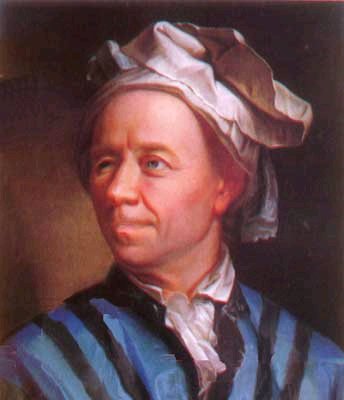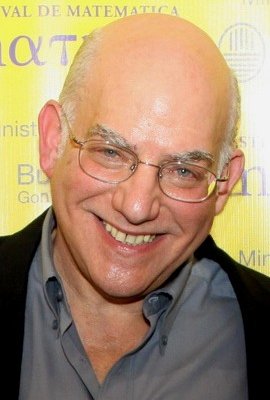“On the shoulders of giant numbers”
http://www.allergrootste.com/big/book/ch2/ch2_3.html
bigΨ
Ψ.2. Up to the Ackermann numbers
chapter 2.3, edit 0.2.9
published: 2011-01-07
updated: 2011-12-30
# 2.3. Deeper than counting
§2.3.1. Transcendence of numbers

Leonhard Euler
Berlin 1753
Transcendental numbers are defined to be those real numbers, which are not
algebraic.
Algebraic numbers give the solutions (roots x)
to polynomial equations, which are composed of addition,
repeated multiplication, constants ai
and an unknown variable x.
The right
meta-statement
repeats the left, growing the x**n exponents.
All polynomials with exponents 0<n<5 are
solvable by
radicals,
but most higher polynomials n≥5
cannot be simplified, as Galois (1832) showed.
For example, the quintic 2×q^5 + 5 = 10×q
is not solvable (Abel 1824), though it has 5 roots.
While the defining polynomial of an algebraic number is enumerable,
often that equation cannot be reduced to a simpler expression.
Of course the unknown x can always be approximated
by iterating over some continuous algorithm…
Generally, for any class of functions there are numbers which cannot be expressed by recursion alone, but can be created by mixing and inverting existing operations. And then there are the higher transcendent numbers that escape any such definition and can only be approached by adopting new rules or by infinite iteration of existing rules.
With the expansion of the function context many formerly
transcendental numbers
run the chance of finding expression.
When a number can be defined by a operation of superpower type,
it is not transcendental any more in the context of
primitive recursive
functions.
This may easily happen to pi π, which lost its
functional transcendence
in the year 1730, when Leonhard Euler
conjured pi
from his Gamma function, essentially a hybrid of the
factorial and exponential functions.
= ½!*(-½)!*-½ = 3.141592653589..
Why for other fractions like
Γ(1/3) and Γ(1/4)
there is no known definition, as Julian Havil notes in his giddy monograph
"Gamma",
we hope you can tell.
In the context of a
factorial
algorithm halves n*(11**-) are still
transcendent
constants.
We like to use the term transcendent for numbers which
cannot be defined within the elementary class of functions
under inverse composition.
Compare the algebraic
polynomials,
which cover the inversion of the function class
up to multiplication totally.
Together with π a host of connected constants may fall from transcendental grace
– foremost ê the base of natural logarithms,
which is connected to π via Euler's famous
theorem.
ê = 1(a**-)**a {a↑ω} = lim (1+1/a)^a {a↑ω} = 2.718281828459..
The ultimate criterion is countability in the sense of
Cantor's
countable sets.
Because enumerable functions with countable parameter values
always create enumerable numbers, the natural numbers
can be used to list all those numbers which are defined by hybrid functions
– finite combinations of finite sets of non-transcendental functions
(strictly countable by a single natural number iterator).
This applies to the number π above, where it is defined by the value
½ in Euler's gamma function –
essentially a hybrid of two operatorials (even though π
can only be generated by an infinite series of one of these algorithms).
§2.3.2. A realm of random reals

Gregory Chaitin
Buenos Aires 2009
Of course there are many algorithms that will approximate pi
ever more closely and that can easily be implemented in a short computer program.
Such a list of commands can be counted,
and in practice always expresses some binary number,
making pi enumerable in many, many different ways.
Our recursive operatorials travel well beyond the algebraic realm,
so the inverted transcendent numbers
that escape the net are a far more elusive set than the common
transcendental.
But both types of numbers are still part of the set of
countable reals – they can be finitely generated.
Random real numbers
are supposed to be based on ω alone,
for they can only be produced by
infinite iteration,
and not by finite combinations of any mathematical algorithm.
We assume the majority of all numbers to be really uncountably deep,
but appear helpless in constructing one…
After that last assumption was put online we were lucky to come across a book by
Gregory Chaitin
written for amateur nerds just like us.
In the book (and in many of his lectures available on YouTube)
Chaitin explains his theorem that the halting probability he calls Omega
is just the right example of such a random real.
He would rather call his algorithmically incompressible numbers
irreducibles
,
but keeps the term random for historical reasons.
Just as well, because there can theoretically be a higher class Turing machine,
which predict if previous machines' programs will halt or not,
so irreducible
is a relative concept in the
hyperarithmetical context.
When we allow the complexity of our algorithms to move beyond exponentiation,
whether any real units can ever be established as
not reducible to algorithmic combinations of the primitive units
1 and - remains unclear.
At the moment we don't even know if the
super-root
a///b of
tetration
can sufficiently be manipulated mathematically to reveal
such discrete recipes for hitherto transcendent numbers.
There's always hope to express random real constants
by clever use of finite recursive algorithms in the future.
Yet the more advanced our mathematical functions, the more elusive the
transcendent numbers that can be generated by application of these functions
to infinite series.
So if transcendence isn't here to stay,
it seems the continuous generation of algorithms
and quasi-random numbers that become ever more real will never stop
…flowing in wider and wilder mathematical streams
towards finite solutions on next higher levels.
A truly infinite and uncomputable phenomenon!